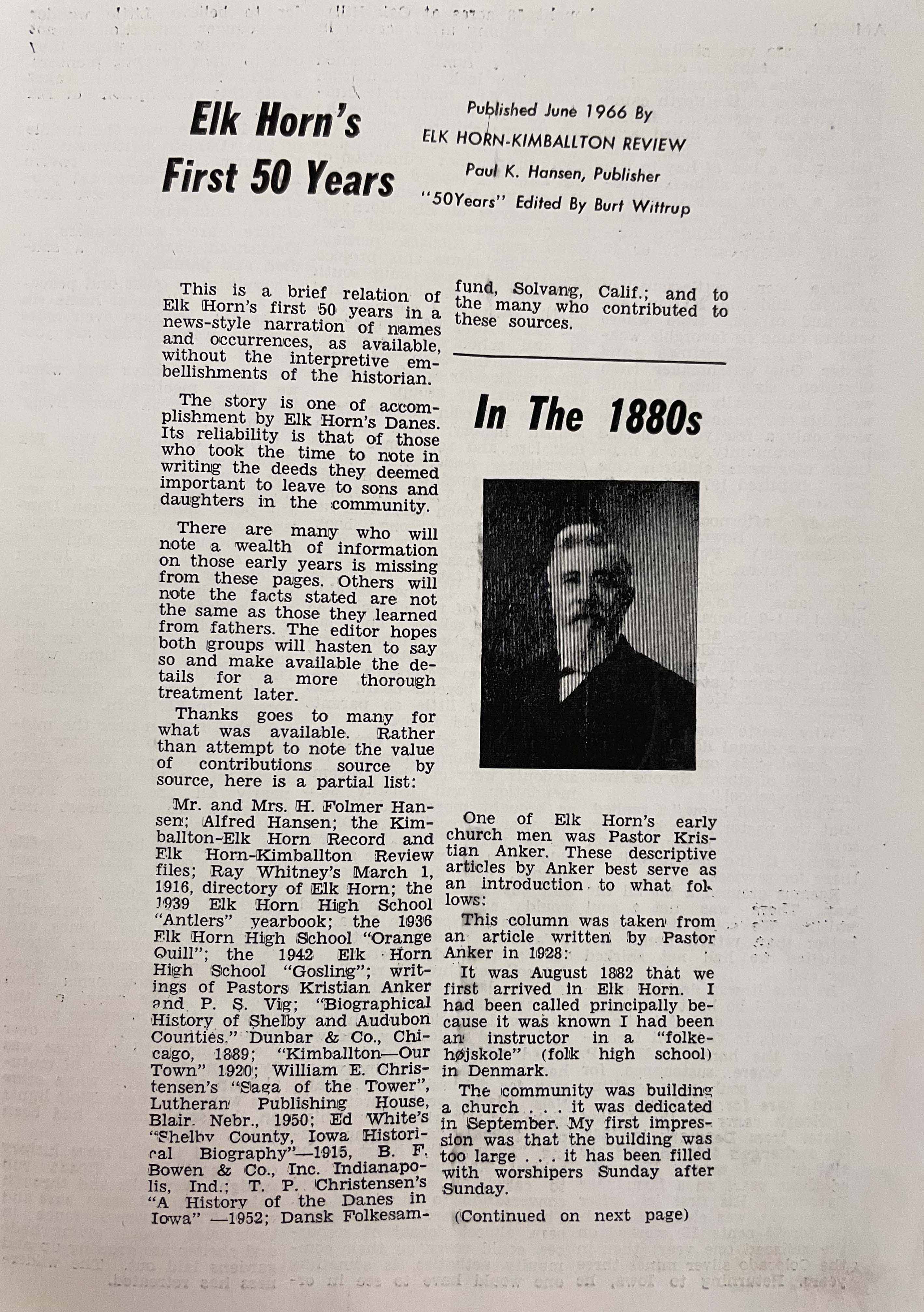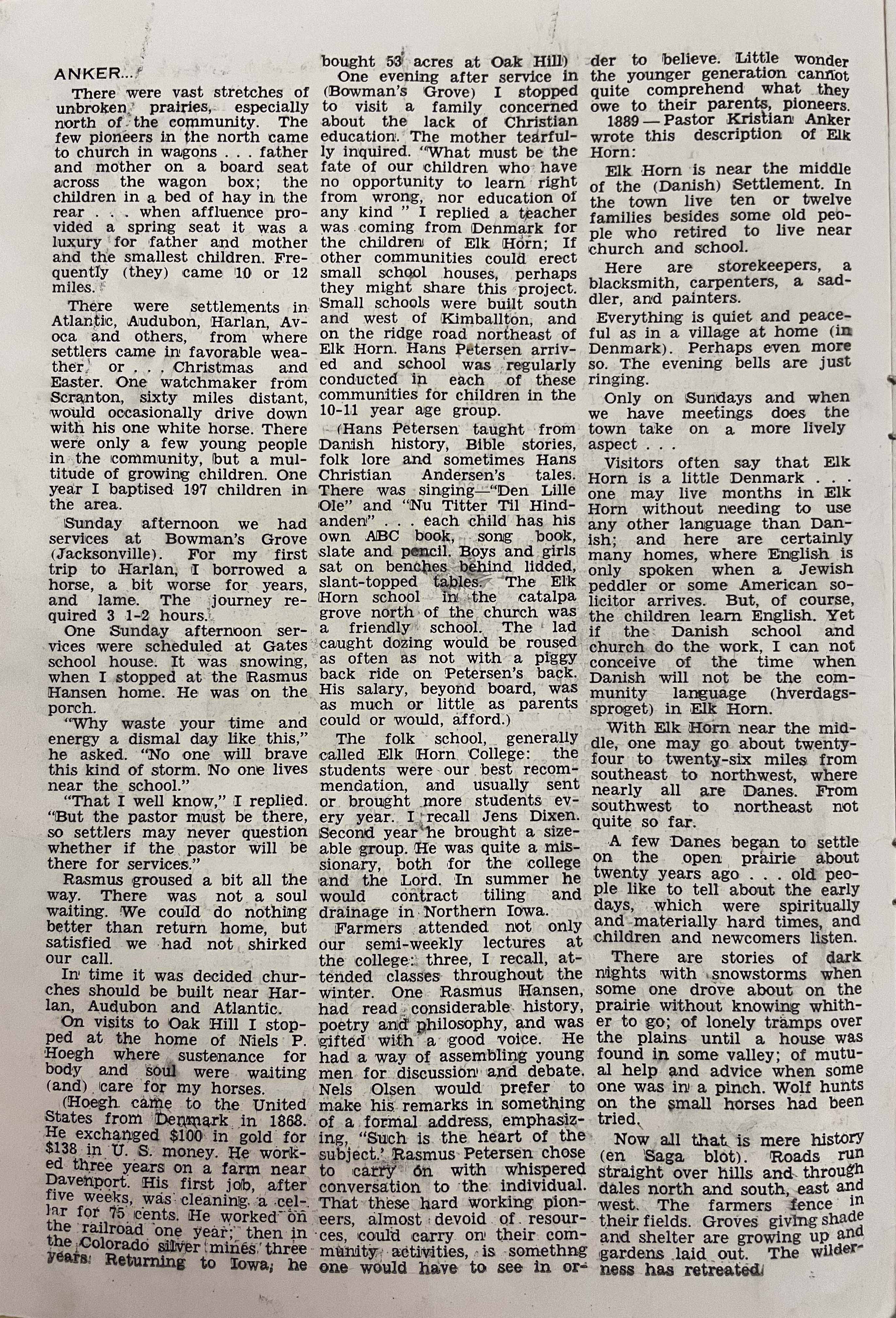|
One of Elk Horn's early church men was Pastor Kristian Anker. These descriptive articles by Anker best serve as an introduction to what follows:
This column was taken from an article written by Pastor Anker in 1928:
It was August 1882 that we first arrived in Elk Horn. I had been called principally because it was known I had been an instructor in a "folkehojskole" (folk high school) in Denmark.
The community was building a church . . . it was dedicated in September. My first impression was that the building was too large . . . it has been filled with worshipers Sunday after Sunday.
There were vast stretches of unbroken prairies, especially north of the community. The few pioneers in the north came to church in wagons . . . father and mother on a board seat across the wagon box; the children in a bed of hay in the rear . . . when affluence provided a spring seat it was a luxury for father and mother and the smallest children. Frequently (they) came 10 or 12 miles.
There were settlements in Atlantic, Audubon, Harlan, Avoca and others, from where settlers came in favorable weather or . . . Christmas and Easter. One watchmaker from Scranton, sixty miles distant, would occasionally drive down with his one white horse. There were only a few young people in the community, but a multitude of growing children. One year I baptised 197 children in the area.
Sunday afternoon we had services at Bowman's Grove (Jacksonville). For my first trip to Harlan, I borrowed a horse, a bit worse for years, and lame. The journey required 3 1-2 hours.
One Sunday afternoon services were scheduled at Gates school house. It was snowing, when I stopped at the Rasmus Hansen home. He was on the porch.
"Why waste your time and energy a dismal day like this," he asked. "No one will brave this kind of storm. No one lives near the school."
"That I well know," I replied, "But the pastor must be there, so settlers may never question whether if the pastor will be there for services."
Rasmus groused a bit all the way. There was not a soul waiting. We could do nothing better than return home, but satisfied we had not shirked our call.
In time it was decided churches should be built near Harlan, Audubon and Atlantic.
On visits to Oak Hill I stopped at the home of Niels P. Hoegh where sustenance for body and soul were waiting (and) care for my horses.
Hoegh came to the United States from Denmark in 1868. He exchanged $100 in gold for $138 in U. S. money. He worked three years on a farm near Davenport. His first job, after five weeks, was cleaning a cellar for 75 cents. He worked on the railroad one year; then in the Colorado silver mines three years. Returning to Iowa, he bought 53 acres at Oak Hill.
One evening after service in (Bowman's Grove) I stopped to visit a family concerned about the lack of Christian education. The mother tearfully inquired. "What must be the fate of our children who have no opportunity to learn right from wrong, nor education of an kind." I replied a teacher was coming from Denmark for the children of Elk Horn; If other communities could erect small school houses, perhaps they might share this project. Small schools were built south and west of Kimballton, and on the ridge road northeast of Elk Horn. Hans Petersen arrived and school was regularly conducted. In each of these communities for children in the 10-11 year age group.
Hans Petersen taught from Danish history, Bible stories, folk lore and sometimes Hans Christian Andersen's tales. There was singing--"Den Lille Ole" and "Nu Titter Til Hindanden" . . . each child has his own ABC book, song book, slate and pencil. Boys and girls sat on benches behind lidded slant-topped tables. The Elk Horn school in the catalpa grove north of the church was a friendly school. The lad caught dozing would be roused as often as not with a piggy back ride on Petersen's back. His salary, beyond board, was as much or little as parents could or would, afford.
The folk school, generally called Elk Horn College: the students were our best recommendation, and usually sent or brought more students every year. I recall Jens Dixen. Second year he brought a sizeable group. He was quite a missionary, both for the college and the Lord. In summer he would contract tiling and drainage in Northern Iowa.
Farmers attended not only our semi-weekly lectures at the college: three, I recall, attended classes throughout the winter. One Rasmus Hansen, had read considerable history, poetry and philosophy, and was gifted with a good voice. He had a way of assembling young men for discussion and debate. Nels Olsen would prefer to make his remarks in something of a formal address, emphasizing, "Such is the heart of the subject." Rasmus Petersen chose to carry on with whispered conversation to the individual. That these hard working pioneers, almost devoid of resources, could carry on their community activities, is something one would have to see in order to believe. Little wonder the younger generation cannot quite comprehend what they owe to their parents, pioneers.
1889--Pastor Kristian Anker wrote this description of Elk Horn:
Elk Horn is near the middle of the (Danish) Settlement. In the town live ten or twelve families besides some old people who retired to live near church and school.
Here are storekeepers, a blacksmith, carpenters, a saddler, and painters.
Everything is quiet and peaceful as in a village at home (in Denmark). Perhaps even more so. The evening bells are just ringing.
Only on Sundays and when we have meetings does the town take on a more lively aspect . . .
Visitors often say that Elk Horn is a little Denmark . . . one may live months in Elk Horn without needing to use any other language than Danish; and here are certainly many homes, where English is only spoken when a Jewish peddler or some American solicitor arrives. But, of course, the children learn English. Yet if the Danish school and church do the work, I can not conceive of the time when Danish will not be the community language (hverdagssproget) in Elk Horn.
With Elk Horn near the middle, one may go about twenty-four to twenty-six miles from southeast to northwest, where nearly all are Danes. From southwest to northeast not quite so far.
A few Danes began to settle on the open prairie about twenty years ago . . . old people like to tell about the early days, which were spiritually and materially hard times, and children and newcomers listen.
There are stories of dark nights with snowstorms when some one drove about on the prairie without knowing whither to go; of lonely tramps over the plains until a house was found in some valley; of mutual help and advice when some one was in a pinch. Wolf hunts on the small horses had been tried.
Now all that is mere history (en Saga blot). Roads run straight over hills and through dales north and south, east and west. The farmers fence in their fields. Groves giving shade and shelter are growing up and gardens laid out. The wilderness has retreated.
  Previous
Previous < == > Next
Transcribed by Cheryl Siebrass, June, 2022, from Elk Horn 1868-1918, pages 1-2.
|